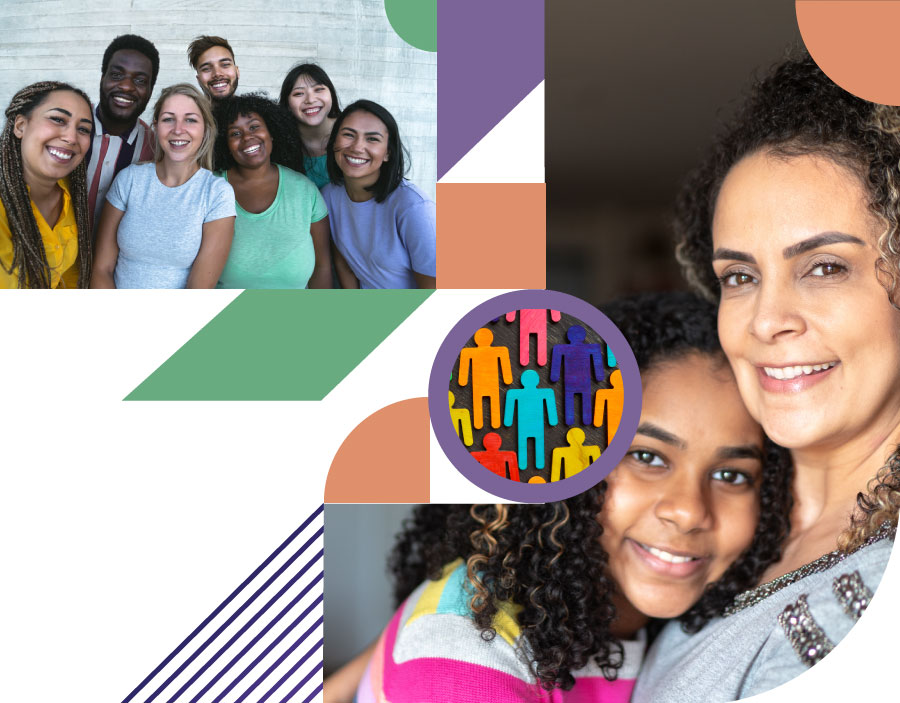Justice, Equity, Diversity & Inclusion
There is a growing acknowledgement that culturally responsive and sustaining practices, including asset-based, play a role in improving post-school outcomes for students and youth with disabilities.
School dropout, out-of-school suspension, health and mental health conditions, poverty, and incarceration are among the factors represented at higher rates by the diverse group of historically marginalized students and youth with disability who identify as Black, Indigenous, and People of Color (BIPOC), English language learners, or lesbian, gay, bisexual, transgender, questioning and other (LGBTQ+). Here are some unfortunate stats to address:
- Latinx with a disability more likely to have less than a high school diploma than other groups (American Community Survey, 2015)
- 51% of African Americans with disabilities who have less than a high school degree live in poverty (American Community Survey, 2015)
- LGBTQ+ youth are more likely to be bullied, drop out of school, and contemplate suicide (Burdge et al, 2014).
- Girls of Color are more likely to experience suspension or expulsion for similar or less offensive behavior than their white counterparts (Annamma, 2018).
- Only 19.4% of marginalized youth with disabilities enroll in postsecondary education compared to 80.6% of their peers without disabilities do (IES, NCES, 2019)
This means that planning, instruction, and school-based and out-of-school transition services for secondary students and youth with disability reflect and incorporate culturally responsive and sustaining practices.
What is Equity?
Equity is promoting justice, impartiality, and fairness within the procedures, processes, and distribution of resources by institutions or systems.
Tackling issues of equity requires an understanding of the root causes of outcome disparities without society.

Source: Definition and image of equity were obtained from eXtension Foundation's webpage.
Culturally sustaining strategies support and value the cultural identities of youth and families to provide effective and supportive services. An example of a culturally sustaining strategy is to recognize the multiple assets which students and youth, their families, and communities bring to transition planning, often referred to as community cultural wealth.
How can transition professionals start using culturally sustaining strategies?
- consider your biases, assumptions, and the ongoing effort to do so - get uncomfortable
- learn about and share the impact of multiple identifiers for students and youth with disability
- plan, instruct, coordinate, and provide services focused on strengths of a student/youth, their family, and community
When transition professionals critically reflect on their own biases, historically marginalized student, youth, and family engagement can be re-imagined.
Resources from Other Sources
- Importance of Gender Affirming Care for Transgender and Gender Expansive Youth
- LGBTQ+ Disability Training Series
- Supporting LGBTQ+ Students in Rural Schools: PD Facilitator Manual for Educators (PDF)
- Guide to Being an Ally to Transgender and Nonbinary Youth (PDF)
- Financial Inequality: Disability, Race, and Poverty in America
- National Center for Systemic Improvement Series on Equity in K-12 Education
- Operationalizing Changes to the Title I Youth Program Under WIOA

What's New
Supporting American Indian/Alaskan Native Students with Disabilities
March 18, 2022MOVE: A Mentoring and Self-Determination Initiative for African American Males with Disabilities
October 21, 2021Getting Started Resources
- Locating and Re-Engaging Secondary Students with Disabilities
- Culturally Responsive Transition Planning Webinar
- Decreasing Dropout Rates for Minority Male Youth
Getting Started Training
Key Resources
Related Topics
Graduation / Dropout
Strategies to reduce the dropout rate and increase graduation rate of all students with disabilities. More about graduation and dropout prevention planning.Transition Planning
Effective practices, resources for implementation, quality IEPs, Program Structure, and Student Development. More about Transition Planning.Pre-Employment Transition Services
Training to begin exploring jobs and career interests through additional VR services and in collaboration with state and local education agencies to students with disabilities. Explore options on how to make available to all students with disabilities who need those services. More about Pre-Employment Transition Services.Postsecondary Education
There are a multitude of education and training opportunities students and youth with disabilities can enroll in. These resources can help prepare students for education/training after high school. More about postsecondary education.Employment
Find resources for career development, early work experiences, work-based learning, career exploration, career assessments, and other effective practices to help students find success in competitive jobs and careers after high school.
